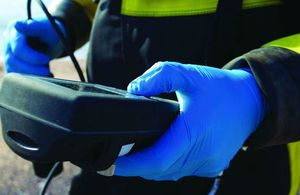Glastonbury Festival fined for causing pollution
Bristol Magistrates Court has ordered Glastonbury Festival Ltd to pay £31,000 after pollution went into the Whitelake River.

One of our staff checking a water sample on site
The organisers of Glastonbury Festival, the world’s biggest music festival, have been ordered to pay £31,000 in fines and costs for pollution offences involving human sewage.
More than 4km of the Whitelake River was polluted after approximately 20,000 gallons of untreated sewage escaped from a temporary storage tank on a farm at Pilton, near Shepton Mallet, on June 29, 2014. The pollution killed more than 40 fish and effectively wiped out the local trout population.
Glastonbury Festival plead guilty to the offence at an earlier hearing. The Environment Agency also asked that an incident from last year’s event involving overflow from a tank fed into by the festival’s ‘long drop’ toilets also be taken into consideration.
Judge Simon Cooper ruled that Glastonbury Festival’s actions after the fish kill had not been negligent and were of low culpability. Hearing the organisers had been issued a caution after the 2010 festival, he ordered that a fine of £12,000 now be payable along with £19,000 costs for the two offences.
The Environment Agency monitors water quality in the Whitelake River throughout the festival using telemetry equipment positioned upstream and downstream of Worthy Farm. Additional monitoring is carried out by the festival’s environmental team who are expected to alert the Agency if they discover pollution within the site.
During a two-day Newton hearing this week, Bristol Magistrates Court heard how the the music festival’s monitoring team failed to alert Environment Agency staff in the agreed manner after sewage leaked into a tributary of the Whitelake River. On-site monitoring detected a spike in pollution at around 1am on June 29.
It was claimed that Glastonbury Festival called the out-of-hours Environment Agency officer on a dedicated telephone line. However, with no call records to prove this had taken place, and with no recollection from the employee, the judge said in the balance of probability the call had not happened.
This failure to alert the Agency through the proper channel resulted in a delay and caused a serious deterioration in water quality.
The judge was satisfied there was a pollution monitoring system in place, and that “conditions were not straightforward” while searching in the dark with a lot of facilities in the vicinity. He praised Glastonbury Festival staff for their efforts in stopping the spill once it was found. He said its actions would have been “unimpeachable” if it had contacted the Agency via the hotline to assist in the search for the pollution.
The source of the pollution was traced to a leaking storage tank at Steanbow Park Farm, Pilton. The tank was installed and operated by Glastonbury Festival Ltd and used to store untreated sewage during the five-day festival.
Festival staff created an earth bund to contain the pollution, which was later removed from site by tanker.
The sewage spill killed at least 42 fish including 29 bullhead – a European protected species – 10 brown trout and 3 stone loach. A fish survey revealed that no trout survived the incident.
On-site monitoring was introduced by the festival organisers following a history of water quality problems during the event.
Ian Withers, Environment Manager for the Environment Agency said:
While we recognise the Glastonbury Festival provides enjoyment to tens of thousands of people and raises money for a number of good causes, the organisers have a responsibility to ensure it does not cause harm to the environment. The festival is held in a beautiful part of the Somerset countryside and we want to see it remain that way.
This was a serious pollution incident that had a significant impact on water quality and the fish population of the Whitelake River over some distance.
Environment Agency staff respond 24/7 following reports to our pollution hotline, 0800 80 70 60. We urge prompt reporting so we can protect water quality and the environment.
ENDS
Note to Editors:
Glastonbury Festival is the world’s largest outdoor music and contemporary arts festival attracting up to 175,000 people to Worthy Farm, Pilton, Somerset every year. Held over 5 days, the festival has been running since 1970 and has grown steadily in size over the years.
A Newton hearing was asked for by Bristol Magistrates Court to decide the gravity of the offence committed. This would have been classed as causing Category 1 or Category 2 damage to the environment. The hearing was also to determine if Glastonbury Festival Ltd was negligent by failing to take reasonable care to put in place proper systems to avoid committing the offence.
At an earlier hearing, Glastonbury Festival Ltd plead guilty to causing a water discharge activity not under or in accordance with an environmental permit, namely the discharge of human sewage derived from the Glastonbury music festival, contrary to regulations 12(1)(b) and 38(1)(a) of the Environmental Permitting (England and Wales) Regulations 2010.
The festival site is situated in a valley at the head of the Whitelake River on the southern edge of the Mendip Hills. Two small streams join on site to form the Whitelake. Although called a river, the Whitelake is a relatively small watercourse.
The Environment Agency’s environmental incident hotline is 0800 80 70 60, more details here: https://www.gov.uk/report-an-environmental-incident